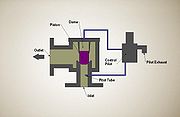
Pilot-operated relief valve
Encyclopedia

Like other pressure relief valves (PRV), pilot operated relief valves (PORV) are used for emergency relief during overpressure events (e.g. a tank gets too hot and the expanding fluid increases the pressure to dangerous levels). The distinction between PORV and conventional PRV is that pilot valves use system pressure to seal the valve. A PRV typically uses a spring to hold the disc or piston
Piston
A piston is a component of reciprocating engines, reciprocating pumps, gas compressors and pneumatic cylinders, among other similar mechanisms. It is the moving component that is contained by a cylinder and is made gas-tight by piston rings. In an engine, its purpose is to transfer force from...
on seat. The essential parts of a PORV are a pilot valve
Pilot valve
A pilot valve is a small valve that controls a limited-flow control feed to a separate piloted valve. Typically, this valve controls a high pressure or high flow feed...
(or control pilot), a main valve
Valve
A valve is a device that regulates, directs or controls the flow of a fluid by opening, closing, or partially obstructing various passageways. Valves are technically pipe fittings, but are usually discussed as a separate category...
, a pitot tube
Pitot tube
A pitot tube is a pressure measurement instrument used to measure fluid flow velocity. The pitot tube was invented by the French engineer Henri Pitot Ulo in the early 18th century and was modified to its modern form in the mid-19th century by French scientist Henry Darcy...
, the dome, a disc or piston, and a seat. The volume above the piston is called the dome.
PORV are also called POSV (Pilot Operated Safety Valve), POPRV (Pilot Operated Pressure Relief Valve), or POSRV (Pilot Operated Safety Relief Valve), depending on the manufacturer and the application. Technically POPRV is the most generic term, but PORV is often used generically (as in this article) even though it should refer to valves in liquid service.
Mode of functioning
The pressure is supplied from the upstream side (the system being protected) to the dome often by a small pitot tube. The downstream side is the pipe or open air where the PORV directs its exhaust. The outlet pipe is typically larger than the inlet. 2”x3”, 3”x4”, 4”x6”, 6”x8”, 8x10” are some common sizes.The upstream pressure tries to push the piston open but it is opposed by that same pressure because the pressure is routed around to the dome above the piston. The area of the piston exposed to pressure is larger in the dome than it is on the upstream side; the result is a net sealing force. F = PA (Force = Pressure * Area)
The pressure from the pitot tube to the dome is routed through the actual control pilot valve. There are many designs but the control pilot is essentially a conventional PRV with the special job of controlling pressure to the main valve dome. When the pilot valve reaches set pressure it opens and releases the pressure from the dome. The piston is then free to open and the main valve exhausts the system fluid. The control pilot opens either to the main valve exhaust pipe or to atmosphere.
Snap Acting:
At set pressure the valve snaps to full lift, it can be quite violent on large pipes with significant pressure. The pressure has to drop below the set pressure in order for the piston to reseat (see blowdown in relief valve
Relief valve
The relief valve is a type of valve used to control or limit the pressure in a system or vessel which can build up by a process upset, instrument or equipment failure, or fire....
article).
Modulating:
The pilot is designed to open gradually, so that less of the system fluid is lost during each relief event. The piston lifts in proportion to the overpressure. Blowdown is typically short.
Comparison to Conventional Pressure Relief Valves
Advantages:- Smaller package on the larger pipe sizes.
- More options for control.
- Seals more tightly as the system pressure approaches but does not reach set pressure.
- Control pilot can be mounted remotely.
- Some designs allow for changes in orifice size within the main valve.
Disadvantages:
- More complex.
- More expensive at smaller sizes (starts to even out as pipe size increases).
- Small parts in pilot valve are sensitive to contaminant particles.

